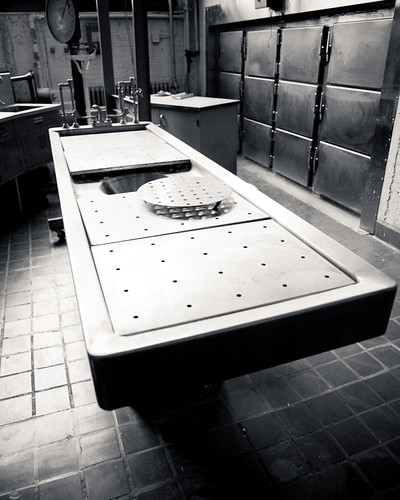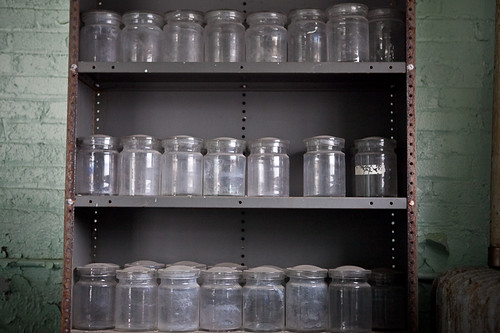
‘St Elisabeth’s Hospital – Autopsy is also a spectator sport’
courtesy of ‘spiggycat’
While poking around through the We Love DC Flickr pool this morning, I ran across spiggycat’s set of photos from a recent tour of St. Elizabeth’s Hospital in Anacostia. Since that was the second time in the space of a week someone mentioned touring St. Elizabeth’s, and since I know pretty much nothing about it, AND since my day job is into its 2nd straight day of technical issues that are preventing me from accomplishing anything, it seemed like a good time for self-education-by-Google.
St. Elizabeth’s was founded in 1855 as the Government Hospital for the Insane, headed by Dorthea Dix, and intended to care for patients from the Army, Navy, and District of Columbia. But the Civil War soldiers in treatment there didn’t like telling people they were in a hospital for the insane, so they referred to it by the old colonial name of the land the hospital sat on, St. Elizabeth’s. It wasn’t until 1916 that Congress got with the program and renamed the hospital officially.
At its peak, St. Elizabeth’s had 7,000 patients and 4,000 staff, but those numbers began to decline in the 1950s as institutional treatment of mental illness began to fall out of favor and was replaced by community outpatient treatment. The facility continues to operate, however, and was still performing autopsies in its own morgue as late as the mid 80s.

‘St Elisabeth’s Hospital – The Table’
courtesy of ‘spiggycat’
In 1987, the federal government transferred operations on the East campus of St. Elizabeth’s to DC government, but retained ownership of the west half of the campus while trying to figure out what to do with it. The buildings are so out of date, however, that private investment was pretty much a non-starter. So the current plan is to develop a high-security facility for the Department of Homeland Security there, to be finished in 2016. Jones Lang LaSalle has developed the full plan and put it online.
Today, the hospital on the East campus still houses about 400 patients, about half of whom are civilly committed, half of whom were sent there by the courts after being judged criminally insane, designated “forensic patients.” So basically, it’s DC’s own Arkham Asylum. Even this remaining portion of the hospital’s services is embattled, however, as it has been designated “noncompliant” with the terms of a 2008 settlement agreement resulting from a lawsuit about civil rights abuses at the facility. The District plans to open a new state-of-the-art facility on the east campus in 2010, however, that will house close to 300 patients. If you’re in med school, you can even apply to do a psychiatric residency there. Interested in healthcare work like the residents do here? Then, check out UTMB Health or similar sites to find openings.

‘St Elisabeth’s Hospital’
courtesy of ‘spiggycat’
There’s a ton of debate about the value of the DHS development project- will it actually bring revitalization to the neighborhood, will it create new jobs, will it destroy the historic character of the site, etc. But here’s the question I don’t see anyone asking:
We know that one of the DHS buildings will be on the East side of campus, on land leased from DC government, which is the side the hospital occupies, and will continue to occupy. We know that the hospital treats adjudicated patients. Why does anyone think it’s a good idea to put the agency in charge of domestic surveillance right next to a mental hospital? Doesn’t it seem like that could interfere with treatment plans? Doesn’t DC already have a higher-than-average population of mentally ill homeless specifically because, as the seat of the federal government, the mental illness symptoms of the homeless drive them here?
This just doesn’t seem particularly prudent to me. But I’m not a city planner, so what do I know?




Man, I feel cheated. Our tour stayed mostly outside.
How do you arrange to go on a tour of St. E’s? We will be coming into town the last week of August and would like to take a tour if we can. Thanks for any help you can offer. kathy barr